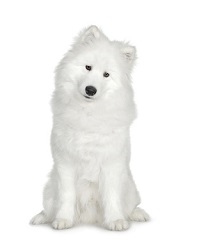 The Samoyed came from the Siberian Samoyede tribes. It was used to herd reindeer, as a sledge dog and as a companion and watchdog. The Samoyed has been used as sled dogs in polar expeditions to the Arctic and the Antarctic. In Siberia, its history as a true working dog means it continues to be used to herd and pull.
The Samoyed came from the Siberian Samoyede tribes. It was used to herd reindeer, as a sledge dog and as a companion and watchdog. The Samoyed has been used as sled dogs in polar expeditions to the Arctic and the Antarctic. In Siberia, its history as a true working dog means it continues to be used to herd and pull.
The Samoyed is a gentle, dependable soul with a great spirit and requiring vigorous exercise.
Personality
The Samoyed is a gentle soul but it is a very high energy breed. Samoyeds are very friendly and sociable and this combined with their need for constant company can make them destructive and noisy when left on their own too long.
When not trained properly, Samoyeds can bark a great deal when they are left unsupervised. They are good with other animals but have a strong herding instinct and also need high fences so they are not distracted by neighboring cats that may provide a good game of chase.
The Samoyed thrives on athletic activities and needs mental stimulation every day, but is happy to be a lounge lizard as well as go for a stroll. They don’t need someone who runs for 10kms every day but benefit from a daily walk.
They are good watchdogs, as they will alert you to visitors, but hopeless as guard dogs. They are easy to train, however, get bored easily and don’t like to repeat activities over and over.
Upkeep
The Samoyed has a double coat – a woolly undercoat and long guard hairs. Once a year for males and once about every eight months for females, they shed the undercoat, losing a massive amount of fur, which resembles wool and require a fair bit of grooming. Otherwise, a quick daily comb is sufficient to maintain their coat condition.
Their undercoat can be used to spin wool and make garments. It is an extremely fine fiber and very warm. A Samoyed should not be clipped in summer as its outer coat acts as insulation. They are clean and odour-free.
It is important to start training young and provide the Samoyed with a good, consistent role model for a leader. Because they are a working dog, Samoyeds need to be kept occupied. They need a great deal of attention and exercise to be happy and not destructive barkers.
Samoyeds love to dig and chew, and also tend to swallow what they chew. This can cause injury such as stomach problem which can be life threatening and expensive to treat. For this reason, they should not be left alone unsupervised in the yard for long periods of time. It is advised to set aside an area in the yard (or house) that is Samoyed-proof – meaning, a concrete floor, plenty of shade and water, and an undercover area in case of rain, along with safe dog toys that cannot be eaten. Samoyeds can be escape artists and secure six foot fencing is also essential.
Compatibility
Samoyeds make wonderful pooches for your family and they love human company and being included in family homes. Samoyeds are gentle enough for families with young children. They are too active for apartment living. Samoyeds are loving and affectionate dogs. You will be rewarded with lots of love and affection if you give your pooch the care and respect they deserve. There is nothing quite like a hug from a Samoyed.
Fact file
Breed classification Utility
Size Medium
Origin Siberia
Lifespan 12 -15 years
Colors White, white and biscuit, cream, biscuit. Cost $1600. Common hereditary problem Hip dysplasia.
